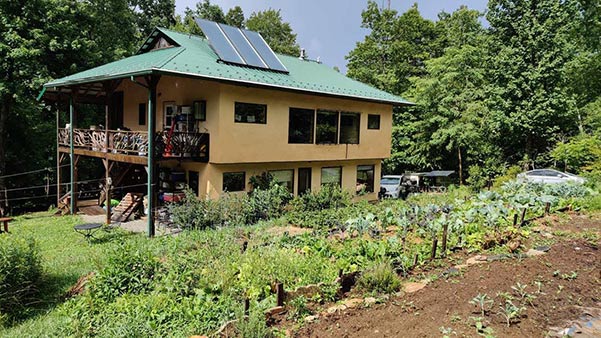Regenerative Earthworks: Harmonizing Land and Life
Regenerative earthworks are a cornerstone of permaculture design, embodying the ethos of working with nature to create thriving ecosystems and regenerative landscapes. This innovative approach to land-shaping focuses on restoring and enhancing natural systems through strategic earth-moving techniques.
By harnessing the power of dams, swales, berms, and other earthworks, regenerative earthworks aim to capture and manage water, prevent erosion, improve soil fertility, and create microclimates conducive to biodiversity and food production.
In this blog post, we’ll explore the principles and practices of regenerative earthworks within the context of permaculture, highlighting its transformative potential for building resilient and regenerative landscapes that benefit both people and the planet.

Principles:
Work with Nature: Regenerative earthworks seek to emulate natural patterns and processes, such as contour lines, water flow, and soil formation, to create landscapes that function harmoniously with the surrounding environment.
Water Management: One of the primary goals of regenerative earthworks is to manage water effectively by capturing, storing, and directing it to where it’s needed most. This may involve the construction of swales, dams, ponds, and terraces to slow down water runoff, prevent erosion, and recharge aquifers.
Soil Health: Improving soil fertility and structure is integral to regenerative earthworks. Techniques such as keyline plowing, sheet mulching, and composting build soil organic matter, enhance nutrient cycling, and promote soil biodiversity.
Biodiversity: Regenerative earthworks aim to create diverse habitats supporting various plant and animal species. These landscapes can foster biodiversity and ecological resilience by incorporating elements such as hedgerows, windbreaks, and wildlife corridors.
Types of regenerative earthworks and their advantages:
1. Contouring:
Contouring is a land-shaping technique that follows the natural curves and slopes of the land to create contour lines.
Advantages:
- Prevents soil erosion: By following the land’s natural contours, contouring helps slow down water runoff, reducing soil erosion and loss of topsoil.
- Water retention: Contour lines create natural basins that capture and retain water, promoting infiltration and groundwater recharge.
- Soil moisture management: Contouring helps distribute water evenly across the landscape, ensuring consistent moisture levels for plant growth.
Examples of Contouring
Contour swales: Shallow ditches dug along contour lines to collect and channel water.
Contour bunds: Raised mounds of soil constructed along contour lines to create barriers that trap water and prevent erosion.
Keyline plowing: Plowing along contour lines using a keyline plow to break up compacted soil and improve water penetration.

2. Swales and Berms:
Swales are shallow channels dug along contour lines to capture and slow water runoff, promoting infiltration and preventing erosion. Berms are raised mounds of soil created adjacent to swales, serving as water-retaining barriers and elevated planting beds for improved drainage and soil fertility.
Advantages:
- Water harvesting: Swales capture and store rainwater, allowing it to infiltrate the soil and recharge groundwater supplies.
- Soil building: Berms built from excavated soil provide elevated planting beds with improved drainage and aeration, fostering healthy soil biology.
- Microclimate creation: Berms can create sheltered microclimates, protecting plants from wind and frost while maximizing solar exposure.
Examples of swales and berms
Food forest swales: Swales are incorporated into food forest designs to capture water and create optimal growing conditions for fruit trees, shrubs, and perennial crops.
Garden bed berms: Raised garden beds constructed from berms filled with compost-rich soil, ideal for vegetable gardening in areas with poor drainage.
Water-harvesting landscape berms: Landscaped berms strategically placed to capture and direct runoff from rooftops and paved surfaces into swales or storage tanks.
3. Terracing:
It transforms steep slopes into manageable, productive landscapes, ideal for agriculture, gardening, and soil conservation in regenerative earthwork practices.
Advantages:
- Slope stabilization: Terraces reduce soil erosion on steep slopes by breaking up the gradient and slowing down water flow.
- Increased arable land: Terraced landscapes create flat, level planting areas on hilly terrain, maximizing usable space for agriculture or landscaping.
- Water conservation: Terraces help retain moisture in the soil by reducing runoff and promoting infiltration, especially in areas prone to drought.
Examples:
Rice terrace systems: Traditional rice cultivation terraces found in regions such as Southeast Asia, where they are used to cultivate rice paddies on mountain slopes.
Permaculture garden terraces: Multi-level terraced gardens designed using permaculture principles to maximize space, water efficiency, and biodiversity.
Soil conservation terraces: Structurally engineered terraces with retaining walls or gabions to prevent soil erosion and landslides in areas with unstable slopes.

4. Ponds and Water Features:
Applying permaculture methods to water features and ponds enhances their functionality, ecological value, and overall regenerative nature.
Advantages:
- Water storage: Ponds serve as reservoirs for storing rainwater, providing a reliable source of irrigation and livestock watering.
- Habitat creation: Pond ecosystems support diverse aquatic and terrestrial life, including fish, amphibians, insects, and waterfowl.
- Cooling effect: Water features such as ponds and fountains can moderate temperatures in the surrounding area, reducing heat stress for plants and animals.
Examples:
Natural ponds: Dug or excavated ponds designed to mimic natural wetland habitats, with shallow areas for aquatic plants and deeper zones for fish habitat.
Swale-connected ponds: Ponds connected to swales or diversion channels to capture runoff and recharge groundwater, enhancing water retention on the landscape.
Wildlife habitat ponds: Designed specifically to attract wildlife, these ponds incorporate features like shallow shelves, submerged logs, and native plantings to support biodiversity.

Regenerative earthworks design is a multifaceted approach to land management that seeks to restore and enhance ecological systems through strategic manipulation of the landscape. By integrating principles of permaculture and employing various techniques and methods, regenerative earthworks can create landscapes that are not only productive and resilient but also harmonious with nature.
How to design regenerative earthworks?
Here are some methods that you can follow as a general rule:
Observation and Site Analysis:
Thoroughly observing and analyzing the site’s topography, soil composition, and water dynamics is crucial for understanding the site’s natural features and identifying potential challenges and opportunities.
This process involves assessing factors such as slope gradients, drainage patterns, soil types, and existing vegetation cover. By gaining a comprehensive understanding of the site, permaculture designers can make informed decisions about the most appropriate earthwork techniques to employ and how to integrate them harmoniously into the landscape.
Design and Planning:
Developing a comprehensive design plan is essential for the successful implementation of regenerative earthwork techniques.
This involves synthesizing information gathered during the observation and analysis phase with the site goals, climate conditions, and available resources. Permaculture design principles such as zoning, sector analysis, and functional integration are utilized to create a holistic and synergistic plan that addresses multiple objectives, such as water management, soil conservation, biodiversity enhancement, and food production.
The design plan serves as a roadmap for guiding the implementation process and ensures that earthworks are strategically located and designed to achieve desired outcomes.
Implementation:
Executing the earthworks according to the design plan requires careful attention to detail and precision in contouring, grading, and construction.
Techniques such as contouring, swale construction, berm building, and terracing are carried out with consideration for site-specific conditions and environmental sensitivity. Implementing earthworks methodically and systematically helps maximize their effectiveness in capturing and managing water, preventing erosion, and enhancing soil fertility.
Minimizing disturbance to existing vegetation and ecosystems during implementation helps maintain ecological integrity and minimize environmental impact.
Maintenance and Monitoring:
Regular maintenance and monitoring of earthworks are essential to ensure their continued functionality and effectiveness in supporting ecosystem health and resilience. This may involve tasks such as clearing debris from swales, repairing erosion damage, and ensuring the proper functioning of water retention structures.
Monitoring water levels, soil moisture, and vegetation health allows designers to assess the performance of earthworks over time and make any necessary adjustments or improvements. By actively managing and monitoring earthworks, practitioners can optimize their long-term benefits and ensure the resilience of the landscape.
Earthaven Ecovillage: A Case Study
Earthaven Ecovillage, located in the mountains of western North Carolina, is an intentional community that embodies the principles of permaculture and regenerative living. Founded in 1994, Earthaven is committed to regenerative practices and living in harmony with the natural world. The community utilizes a variety of regenerative earthworks techniques to manage water, enhance soil fertility, and create resilient landscapes.

WATER MANAGEMENT
One of Earthaven’s key focuses is water management, given its importance for human needs and ecological health.
Swales: Earthaven has constructed swales along contour lines to capture and slow water runoff, allowing it to infiltrate the soil and recharge groundwater. These swales help to prevent erosion, retain moisture, and support vegetation growth.
Ponds: Several ponds have been built throughout the ecovillage to store rainwater and provide a habitat for aquatic life. These ponds serve as valuable resources for irrigation, wildlife habitat, and recreation while also contributing to groundwater recharge.
Greywater Systems: Earthaven utilizes greywater recycling systems to reuse water from sinks, showers, and laundry for landscape irrigation. This reduces freshwater consumption and minimizes wastewater discharge, contributing to overall water conservation efforts.
SOIL FERTILITY
Regenerating and maintaining soil fertility is another priority at Earthaven, essential for regenerative organic agriculture and food production.
Composting: Earthaven residents practice composting on-site to recycle organic waste and create nutrient-rich compost for soil amendment. Compost piles are carefully managed to optimize decomposition and microbial activity, producing high-quality soil conditioners for gardens and orchards.
Mulching: Mulching with organic materials such as leaves, straw, and wood chips helps retain soil moisture, suppress weeds, and add organic matter to the soil. Mulch is applied around plants and in garden beds to improve soil structure and fertility.
LAND STEWARDSHIP
Earthaven values stewardship of the land and strives to regenerate ecosystems while meeting human needs. Through permaculture design and regenerative earthworks techniques, the community enhances biodiversity, restores degraded landscapes and promotes ecological resilience. Residents actively engage in land restoration projects, reforestation efforts, and habitat enhancement initiatives to create thriving ecosystems that support both people and nature.
Earthaven Ecovillage serves as a living example of how principles and techniques of regenerative earthworks can be applied in a community setting to create lasting, resilient landscapes and promote harmonious coexistence with the natural world.

Together, let us embark on this journey of stewardship and co-creation, one mindful action at a time, to cultivate a thriving and resilient world for all. Permaculture Design is our ticket to a greener, happier planet. If you want to learn more about regenerative design – become a certified Permaculture Designer with us!
